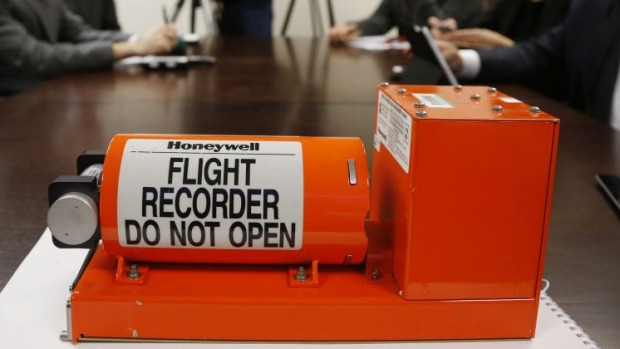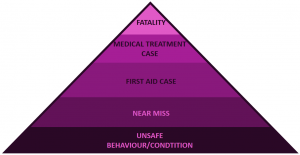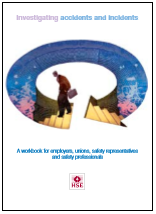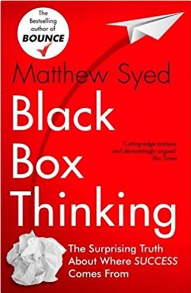Not only are they not a 1990’s Italian house music band, they are not even black!
Air crash investigations often hang on the outcome of a review of the black box recorder. Unlike any other industry, the air travel industry actual invest in incident investigation before any accident has occurred. The black box device is a regular passenger on all commercial air flights. Although, thankfully, rarely called upon to provide evidence, it is a n essential part of incident investigations. This and other aspects of investigation methodology sets the airline industry well above any other industry sector in learning from and preventing re-occurrence of accidents. And, as the headline above suggests, they are rarely if ever black. Typically they are red or orange in colour to aid their location at a crash scene.
n essential part of incident investigations. This and other aspects of investigation methodology sets the airline industry well above any other industry sector in learning from and preventing re-occurrence of accidents. And, as the headline above suggests, they are rarely if ever black. Typically they are red or orange in colour to aid their location at a crash scene. Ordinarily there are two types of flight recorder, the FDR, Flight Data Recorder and the CVR, Cockpit Voice Recorder. These each do exactly as their name suggests. The information they provide helps determine the true root cause of events. Such learning is shared with competitors and aircraft manufacturers to ensure that such an accident never occurs again. Here at BITS we are committed to accident prevention and take a keen interest in accident investigations. We also review the records of the Federal Aviation Administration and others to gather up learning from these leading edge investigations. One observation we make is that these investigations are thorough and without prejudice. Though the accidents have a huge commercial impact, the investigations are conducted independently and largely without consideration to the cost. Furthermore, they do not consider the human resource implications of the facts. That is the key word, it is all about the facts. What the airline eventually does with the facts is up to them, however, the reputation of manufacturers, the commercial impact to couriers, the career impact to individuals is not allowed to impact the investigation. They are driven by the dogged pursuit of the truth.
Ordinarily there are two types of flight recorder, the FDR, Flight Data Recorder and the CVR, Cockpit Voice Recorder. These each do exactly as their name suggests. The information they provide helps determine the true root cause of events. Such learning is shared with competitors and aircraft manufacturers to ensure that such an accident never occurs again. Here at BITS we are committed to accident prevention and take a keen interest in accident investigations. We also review the records of the Federal Aviation Administration and others to gather up learning from these leading edge investigations. One observation we make is that these investigations are thorough and without prejudice. Though the accidents have a huge commercial impact, the investigations are conducted independently and largely without consideration to the cost. Furthermore, they do not consider the human resource implications of the facts. That is the key word, it is all about the facts. What the airline eventually does with the facts is up to them, however, the reputation of manufacturers, the commercial impact to couriers, the career impact to individuals is not allowed to impact the investigation. They are driven by the dogged pursuit of the truth.
Do other industries have the same desire to find the truth?
So we ask ourselves, do other industries have the same desire to find the truth? While they say they do, experience tells us that most organisations hit a wall in investigations. A wall built from resource constraints, time factors and commercial reputation. When this wall is hit, the investigation generates a report and a line is drawn. This is not to say that we don’t see worthwhile learning, however do we learn everything that we could from the incidents? Our contention is, no we don’t. This is especially the case when human factors are involved.
Many industrial investigations go into great detail about metallurgy, latent defects and material failures. However, when human factors are involved they often stop at ‘human error’. In all too many cases once human error is identified, the remedial action is disciplinary. The guilty individual is found and dealt with. Sadly, we have seen this so many times, and there is a huge danger and tremendous risk in this approach. While the managers involved may believe that they have taken swift and decisive action to deal with the cause, this is far from the case. By disciplining or dismissing an individual who committed a violation or made an error, all you have achieved is to ensure that that person does not cause that accident at your place of work again, probably. Identifying a human factor and then addressing the human involved is to miss a massive opportunity to reduce accidents.
Rather than jump to a disciplinary process, time is better spent exploring the reasons behind the behaviour. Ask why, then why, then why, then why again, then why and why and why until you have the root cause of the incident. People don’t deliberately hurt themselves or others. So to address the person rather than the behaviour is to fail in your duty to investigate incidents. In a nutshell by targeting the person we prevent maybe one future event, by addressing the behaviour and sharing our learning we can prevent all future events. Why wouldn’t we do that?
Not only does an incomplete investigation prevent you from getting to the cause of an incident, behavioural science suggests it damages the overall performance of you and your team. Failure to acknowledge and learn from mistakes creates a culture where everyone feels they are good enough already. With no drivers for improvement, why take a risk and get out of your comfort zone to explore your true capability? Show me a company that fails to investigate incidents or brushes things under the carpet and I’ll show you a business that is way off its true potential.
Include a behavioural analysis tool in your incident investigation process.
Many people who perform incident investigations are not trained in human factors analysis. In fact, it would be fair to say, that many people who perform incident investigations are not trained in performing incident investigations. Ensuring people are trained and competent is the first step. There is a skill to performing an investigation. You may feel that comparing your industry to the airline industry is unfair, after all if a pilot makes a mistake and crashes a plane, hundreds of lives could be lost, you may not have that kind of risk at your place of work. In truth, every workplace has the capacity to create a fatality, by not learning from our near misses and minor incidents we are simply increasing this likelihood.
When you discover that an accident is the result of someone breaking the rules or making a mistake due to lack of attention to detail, before there is any thought of disciplinary action, dig further to find out why they did what they did. In our experience, in organisations where disciplinary action is often the outcome of investigations, people have this at the front of their minds. This means that witness statements are guarded. People may withhold documents or fail to volunteer information through fear of retribution. So not only are you failing to investigate the true causal factors, you are also removing the opportunity to discover all the facts that might allow you to do this. We have even found organisations who read a prepared caution warning of disciplinary action or dismissal before taking a witness statement. This pretty much guarantees that you will not get to the truth behind the incident. If you have read this and thought ‘we do that’, please think about your process. If you tell someone that they are in line for some disciplinary action that may effect their ability to support their family and diminish their career advancement; how likely are they to tell you everything that happened?
The only reason you investigate an accident is to make sure it never happens again.
Shall we say that again? The only reason you investigate an accident is to make sure it never happens again. The focus must be on cause not blame. If you set out looking to pin the blame on someone you will miss the point of the investigation. Likewise, if you seek to blame an inanimate object rather than accept a human cause, you are blinkering yourself to the facts from the outset. Even when equipment failure is the cause of an incident, you most often find it has been maintained incorrectly, installed poorly, manufactured with a defect or designed without considering all the relevant factors. All of which involve a human. Some organisations, I shall not mention any, set out to protect themselves and their people rather than find the true cause of an accident. Forget the impact or potential impact (you can manage that later), you must uncover the facts to determine the true cause of an event in order to prevent it happening again.
Time for some bullets.

We are all aware of Bird’s triangle. The premise being that minor events lead to major events. There are only so many near misses we can ‘get away with’ before we have an accident. So the trick is to learn from our minor events to avoid a major event. As such it is essential that all investigations achieve their aim of identifying the true root cause of events. With this in mind here is some guidance to achieve just that.
- Train your investigators. Don’t assume that people in your organisation can investigate incidents by virtue of the fact that they are managers. Incident investigation is a skill.
- Keep your distance. Ensure that those who are investigating are as independent as possible. For instance, don’t allow line managers to investigate incidents involving their own team. Consider importing people from different locations within your business.
- Establish the objective, you are looking for the facts not someone to blame. Investigations are performed only to establish the truth. Do not caution witnesses, avoid a reputation for disciplinary action.
- Include behavioural analysis in your process. If a person made a mistake or broke a rule deliberately, you need to know why. Bring in experts if you have to.
- Don’t just focus on the outcome of the incident, think about the potential outcome. If it could have been serious, then treat it as such.
- Don’t jump to disciplinary. Going straight to disciplinary action devalues the process and disillusions the team. You may need to take action at some point, but only once all the facts are established and all learning is done. Then such action can be in the context of the real behavioural drivers.
- Accountability not blame. Hold people accountable for their actions and involve them in the delivery of the solutions.
- Segregate responsibilities. Allow the investigation team to find the cause and make recommendations, then leave the action plan to the management team.
- Be thorough but quick. Until you have established the cause of an incident you are operating with an unknown risk. An unknown risk cannot be effectively mitigated. Furthermore, you may not be the only one operating with this risk. It is essential to determine a cause as soon as possible to minimise the future risk. This may require additional resources.
- Avoid speculation. As soon as a high profile incident impacts an organisation, senior management want to know the cause. You may well be questioned regarding the cause or likely cause. Refrain from answering such questions until the report is concluded, even if the cause looks reasonably obvious form the outset.
If you are going to investigate an incident, you might as well do it properly. Failing to establish the root cause simply increases the level of risk in your business. Moving planes around the world is a very visible business. When things go wrong, everyone wants to know what happened and what is being done to prevent it happening again. This has resulted in the development of a world class incident investigation process, the techniques of which are available to us all. Just like the airlines who place black box recorders on board in readiness for an unplanned event, we too can set ourselves up in advance. Develop a standard process for investigating incidents and familiarise your team with this process. That way, should the worst happen, people will approach the investigation, not with reticence and a fear of retribution, but with honesty and a desire to find the truth.
 For more information on incident investigation read the UK HSE Workbook HSG245.
For more information on incident investigation read the UK HSE Workbook HSG245.
 Matthew Syed’s book, Black Box Thinking provides a behavioural angle on how learning from our mistakes can significantly improve performance
Matthew Syed’s book, Black Box Thinking provides a behavioural angle on how learning from our mistakes can significantly improve performance
